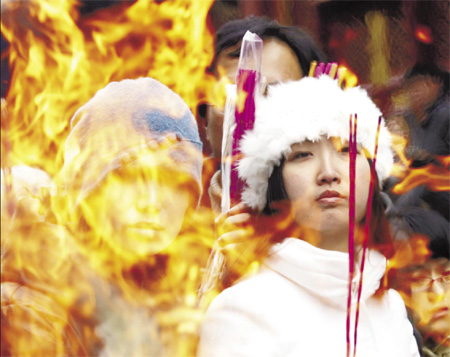Buddha hears thousands of wishes
More than 43,000 people went to Yonghegong, or the Lama Temple, to burn incense on Sunday, the last day of the Spring Festival and the 15th day of the lunar calendar.
That figure was 8,000 more than on the same lunar day last year, although well below the 60,000 that passed through the temple's gates on the first day of this year's Spring Festival.
Yonghegong stopped ticket sales at 4:30 pm and the precise figure given did not include complimentary tickets given out to lay Buddhists, said Wang Jinhua, chief of the administrative department at the temple.
The first and 15th day of every lunar month are typically the busiest days for temples in terms of guests because tradition dictates these are the days when Buddha is on duty.
|
|
|
People burn incense at the Lama Temple on Sunday to mark Lantern Festival. [China Daily] |
And the first month is particularly special because followers of the faith come to make wishes for the entire year.
"I came here to burn incense with a friend because I was in my hometown in Liaoning province on the first day of the Lunar New Year," said a woman surnamed Guo.
Guo said she returned to Beijing for work on Feb 20. She came to the temple following advice from a friend who suggested she pass her wishes directly to Buddha.
She told METRO she asked the spiritual teacher to ensure her family remained healthy in the following year.
The temple saw such a heavy turnout Sunday that it took visitors more than three minutes to climb the six steps into the temple hall. Incense filled the temple and venders selling the goods were plentiful.
"Our busiest period was the first hour of ticket sales," said Wang.
He said more than 7,000 people entered the temple between 8 and 9 am, and it had reached 20,000 by 11 am.
The temple started selling tickets at 7:40 am - 20 minutes ahead of schedule - because of a large queue outside the gate, Wang said, which he estimated was longer than 500 m.
He added that his staff did not have time to answer questions on the day, and that more ticket windows were opened to cope with the demand.
 0
0 







